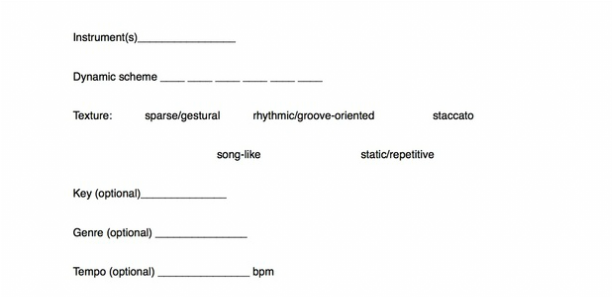 I'm so excited to finally bring this idea to life! I've used improvisation in my practice sessions, compositions, performances and teaching for quite some time and have felt its positive effects. I hope that you enjoy your journey throughout the posts and share your experiences with me along the way. Let's do this! We will begin the series by focusing on how to start implementing aspects of improvisation into your own practice sessions. Throughout, we will progress into using it as a practice tool and as creative and compositional techniques. The purpose of this class is to show you ways to gain a new comfort level while improvising. Without that, moving on in this series will be difficult because you will never shake that uneasy feeling. The first thing that you should do is pick an instrument that you are most comfortable on and play! Don't worry about meter, scales, key, harmony, timing, etc... Try to think in larger scale phrasing and gestures and experiment more with color- how many different sounds can you produce on the instrument? These "colors" may be different stroke or lift types, ornaments, articulations, placement of the hand or stick on the drum, bar, etc. and more. Don't forget that you always need to practice the foundation elements on the instruments we play. This means scales, rudiments, stroke speeds/types, etc. If your technique is lacking and then you decide to improvise in a more structured environment, your technique will still sound like it is lacking. In other words, you need to be able to make a good sound without thinking about it. Your brain will have tons of other things to focus on while creating on the fly and the last thing you want is a great idea that doesn't sound so good coming off of the instrument. On the other hand, developing creativity on your instrument only happens when you have time to experiment and just play without the confines of music. I recommend going through your normal practice routine and then incorporating a chunk of time to just experiment. The trick is actually blocking out that time and then making a commitment to it. This is the difficulty for those of us who are working musicians. I know myself that when I think about my weekly practice schedule it often fills up with new music that needs to be learned on top of my daily technique refreshers. I'm not recommending that you change your routine, but just try to fit an improvisation into your daily practice until you gain some confidence. Otherwise, so much time is spent on learning repertoire and techniques that simply learning our instruments and more importantly our body's limits on those instruments are not even on the radar. You can only connect the dots between the music that you play and why you express it the way that you do when you understand what is between them- YOU. If you are still not sure where to begin, you could even start by improvising over songs. Just try to avoid playing typical drumset patterns for this particular step. Remember that the first stage is all about experimenting and gaining confidence. Once you are ready to begin a free improvisation, some structure may still be required. The following chart will give you a place to begin. Be sure to record every session so that you can listen and watch yourself play. This is an essential part of the practice that I do because I feel that it holds me accountable for my music making like there is an audience in the room. It also is great to assess your body language as a performer because if you can sell improvised music, you can certainly sell a piece that you have studied for a period of time. Below are examples of myself improvising using different instruments (wear headphones if possible). While recording these, I had three different goals in mind: 1. Try to take on a different character for each 2. Play musically (dynamics, creation/development of themes, phrasing...) while using conventional and non-conventional playing techniques 3. Feel and portray confidence and comfort I also want to stress that these clips are unedited with the exception of the occasional fade out (for looks!). This music is inspired by the moment in which it occurs! In the paraphrased words of Stefon Harris in his TED Talk...there are no mistakes, just missed opportunities... Try to practice at least one free improvisation each day on a new instrument or groups of instruments. Challenge yourself to make the style, mood and sounds you create different each time. Feel free to repeat or recreate a particular session using new instruments as well. Don't forget to record yourself every time.
Next time, we will focus on non-pitched instruments while introducing a bit of structure. Feel free to share your own improvisations based on this post by emailing me at [email protected] or by becoming my friend on facebook and/or following me on instagram at the links below. I'd love to create a network of percussion #improvisers this way!!
2 Comments
|
AuthorAnthony Di Bartolo is a New Jersey-based percussionist, composer, and educator. Archives
June 2019
Categories |

 RSS Feed
RSS Feed